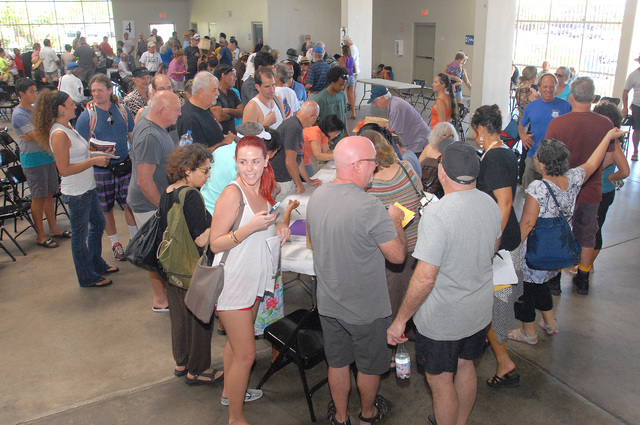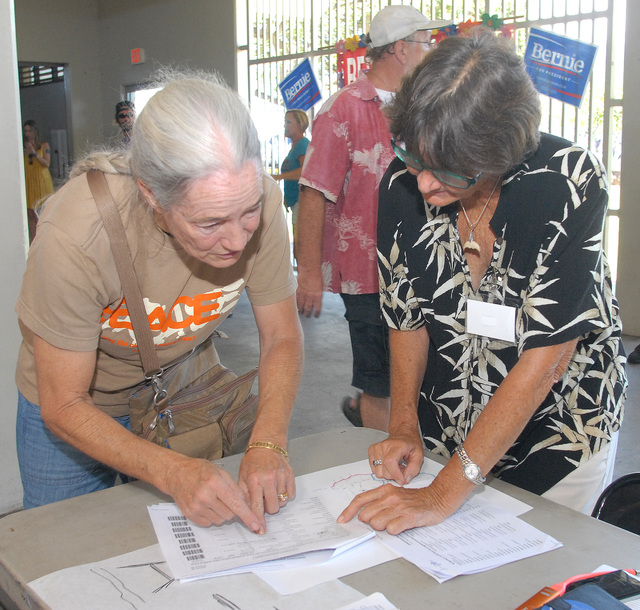KAILUA-KONA — It was excitement, confusion, and yes — frustration. ADVERTISING KAILUA-KONA — It was excitement, confusion, and yes — frustration. The level of new voter participation in last Saturday’s Presidential Preference Poll, along with voters left in the cold
KAILUA-KONA — It was excitement, confusion, and yes — frustration.
The level of new voter participation in last Saturday’s Presidential Preference Poll, along with voters left in the cold after the doors closed, has party officials looking at ways to improve the process in the future.
In all, the Big Island cast 7,254 ballots, up 23.6 percent from the 5,868 total for 2008, when masses of voters came out to support Barack Obama.
“I never thought it would happen,” said Phil Barnes, Hawaii County chairman for the Democrats.
Bernie Sanders took 5,605 votes, and 1,649 ballots were cast for Hillary Clinton. The energy that helped propel Sanders’ big win also led to long lines and highlighted a lack of knowledge about how the process works, with some voters failing to show up on time and others looking to the wrong sources for voting information.
The Democratic Party is still counting forms and won’t know for days just how many new members it has, but party officials expect the statewide number to be significant. Barnes attended several polling sites in Hilo and estimated that at least 40 percent of the voters were new and had to sign up at the enrollment table.
“That slowed it down tremendously,” he said.
Stephen Schleder took off work early and drove nearly 30 miles from the Mauna Lani to Kohala High School, where he found his polling place closed around 3 p.m., the volunteers packed up and headed home two hours after the start of voting.
“You got an hour to vote? That’s ridiculous,” he said. “There are people who have to make a living. You should leave the polls open until every vote has been cast.”
Historically, there hasn’t been a set time to close the presidential preference poll. Instead, anyone who is in line after the meeting has concluded is allowed to vote, and the party urges caucus-goers to line up promptly before voting starts. In the past, there haven’t been problems, Barnes said. But there also hasn’t been the level of turnout seen this past weekend.
“This will be a heavily discussed issue at our convention on April 30,” Barnes said.
On the east side, Jim Albertini of House District 3 voted at the Keaau Community Center, where he arrived before noon and found hundreds already waiting in line. He stayed until 3 p.m.
“No telling how many gave up voting because of a lack of parking and confusion,” he said in an email.
In Ocean View, party officials reopened the polls to accommodate several people who showed up late, said Barbara Dalton, West Hawaii vice chairwoman for the party. At Makaeo Events Pavilion, officials did the same thing.
The polling process can be shrouded in confusion. Many folks wonder why the term “caucus” is used to describe the event. In the strict sense of the term, that is an event where speeches are made and people try to sway voters to a particular candidate before ballots are cast. On its website, the party tries to address the distinction, stressing that the poll is not a caucus.
“The poll has some similarities with other caucuses,” the site states. “The Democratic Party of Hawaii organizes and pays for the poll. The poll results will decide how Hawaii splits our 34 delegates to the Democratic National Convention. The polls are conducted at the local level. But unlike a caucus, the voting in Hawaii is by secret ballot.”
In another case of confusion, voters frequently call the Office of Elections trying to get information the office doesn’t have. Dalton noted the poll is a party function, not an election, and people should call the party for information. Not everyone understands that, she said.
“There is an amazing amount of confusion surrounding the process,” Dalton said.
Nine of Hawaii’s delegates are superdelegates, and can vote for whichever candidate they want. These delegates are generally current or former Democratic elected officials and members of the Democratic National Committee. But the other 25 “pledged” delegates are determined by the voters. Sanders, with 70 percent of the 33,716 ballots cast statewide, has won 17 of the pledged delegates and Clinton has won eight.
The poll is the only time the general public gets to help choose a presidential candidate before the November general election.
There will also be a primary election in August, but the presidential candidates will not be on the ballot, Dalton said. That is yet another point of confusion for some.
Last Saturday’s presidential preference poll held at 14 locations around the island was run entirely by volunteers, who did a great job, Dalton said. There were the lines, frustration from people who wrongly thought they were already registered Democrats, and those who showed late. For previously registered Democrats, though, the polling seemed to go smoothly, Barnes said.
But the issue of doors closed on voters does need to be examined, he acknowledged.
“I’m sure we’ll do something about it next time,” Barnes said.




